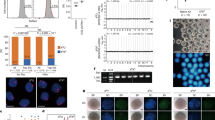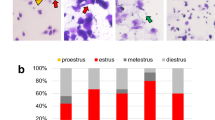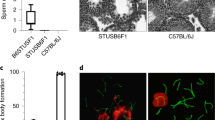Abstract
Superovulation is often used to increase the number of oocytes that can be collected from donor females for in vitro fertilization. Donor age can affect the quantity and quality of oocytes produced during superovulation, and in some strains of mice juvenile females are optimal donors. The authors reviewed donor and oocyte records from a breeding program to evaluate how donor age affects the number and fertilization efficiency of oocytes collected from C57BL/6J mice. Generally fewer oocytes per donor were collected from females aged > 32 d than from females aged 21–32 d. Fertilization efficiency of oocytes generally declined with donor age when oocytes were fertilized with fresh or with stored sperm. These findings suggest that the use of younger C57BL/6J donors, instead of older donors, can reduce the number of donors needed for IVF procedures.
This is a preview of subscription content, access via your institution
Access options
Subscribe to this journal
We are sorry, but there is no personal subscription option available for your country.
Buy this article
- Purchase on Springer Link
- Instant access to full article PDF
Prices may be subject to local taxes which are calculated during checkout



Similar content being viewed by others
References
Russell, W.M.S. & Burch, R.L. The Principles of Humane Experimental Technique (Methuen, London, 1959).
Edgar, D.H., Whalley, K.M. & Mills, J.A. Effects of high-dose and multiple-dose gonadotropin stimulation on mouse oocyte quality as assessed by preimplantation development following in vitro fertilization. J. In Vitro Fert. Embryo Transf. 4, 273–276 (1987).
Legge, M. & Sellens, M.H. Optimization of superovulation in the reproductively mature mouse. J. Assist. Reprod. Genet. 11, 312–318 (1994).
Johnson, L.W., Moffatt, R.J., Bartol, F.F. & Pinkert, C.A. Optimization of embryo transfer protocols for mice. Theriogenology 46, 1267–1276 (1996).
Luo, C. et al. Superovulation strategies for 6 commonly used mouse strains. J. Am. Assoc. Lab. Anim. Sci. 50, 471–478 (2011).
Nagy, A., Gertsenstein, M., Vintersten, K. & Behringer, R. (eds.) Manipulating the Mouse Embryo: A Laboratory Manual 3rd edn. (Cold Spring Harbor Laboratory Press, Cold Spring Harbor, NY, 2003).
Miyoshi, I. et al. Effect of environmental factors on the yield of mouse embryos obtained after hormone-induced superovulation. Lab. Anim. Sci. 43, 642–645 (1993).
Vergara, G.J., Irwin, M.H., Moffatt, R.J. & Pinkert, C.A. In vitro fertilization in mice: strain differences in response to superovulation protocols and effect of cumulus cell removal. Theriogenology 47, 1245–1252 (1997).
Zarrow, M.X. & Wilson, E.D. The influence of age on superovulation in the immature rat and mouse. Endocrinology 69, 851–855 (1961).
Gates, A.H. & Bozarth, J.L. Ovulation in the PMSG-treated immature mouse: effect of dose, age, weight, puberty, season and strain (BALB/c, 129 and C129F1 hybrid). Biol. Reprod. 18, 497–505 (1978).
Sugiyama, F., Kajiwara, N., Hayashi, S., Sugiyama, Y. & Yagami, K. Development of mouse oocytes superovulated at different ages. Lab. Anim. Sci. 42, 297–298 (1992).
Ozgunen, K.T. et al. Effect of gonadotrophin dose on oocyte retrieval in superovulated BALB/c mice. Theriogenology 56, 435–445 (2001).
Spearow, J.L. Major genes control hormone-induced ovulation rate in mice. J. Reprod. Fert. 82, 787–797 (1988).
Spearow, J.L. Characterization of genetic differences in hormone-induced ovulation rate in mice. J. Reprod. Fert. 82, 799–806 (1988).
Hoogenkamp, H. & Lewing, P. Superovulation in mice in relation to their age. Vet. Q. 4, 47–48 (1982).
Byers, S.L., Payson, S.J. & Taft, R.A. Performance of ten inbred mouse strains following assisted reproductive technologies (ARTs). Theriogenology 65, 1716–1726 (2006).
Ostermeier, G.C., Wiles, M.V., Farley, J.S. & Taft, R.A. Conserving, distributing and managing genetically modified mouse lines by sperm cryopreservation. PLoS ONE 3, e2792 (2008).
Suzuki, H., Yorozu, K., Watanabe, T., Nakura, M. & Adachi, J. Rederivation of mice by means of in vitro fertilization and embryo transfer. Exp. Anim. 45, 33–38 (1996).
Sztein, J.M., Farley, J.S. & Mobraaten, L.E. In vitro fertilization with cryopreserved inbred mouse sperm. Biol. Reprod. 63, 1774–1780 (2000).
Takeo, T. & Nakagata, N. Combination medium of cryoprotective agents containing L-glutamine and methyl-β-cyclodextrin in a preincubation medium yields a high fertilization rate for cryopreserved C57BL/6J mouse sperm. Lab. Anim. 44, 132–137 (2010).
Woods, S.E. et al. Laser-assisted in vitro fertilization facilitates fertilization of vitrified-warmed C57BL/6 mouse oocytes with fresh and frozen-thawed spermatozoa, producing live pups. PLoS ONE 9, e91892 (2014).
Gates, A.H. Viability and developmental capacity of eggs from immature mice treated with gonadotrophins. Nature 177, 754–755 (1956).
Acknowledgements
We thank Dalma Batkay for editing the manuscript.
Author information
Authors and Affiliations
Corresponding authors
Ethics declarations
Competing interests
The authors declare no competing financial interests.
Rights and permissions
About this article
Cite this article
Kolbe, T., Landsberger, A., Manz, S. et al. Productivity of superovulated C57BL/6J oocyte donors at different ages. Lab Anim 44, 346–349 (2015). https://doi.org/10.1038/laban.746
Received:
Accepted:
Published:
Issue Date:
DOI: https://doi.org/10.1038/laban.746



